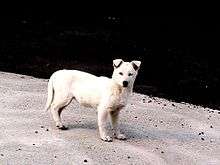Jeju dog
 | ||||||||||||||||||
| Other names |
Jeju Chaeju Jeju Dog JejuGae (based on the Hanja spelling) | |||||||||||||||||
|---|---|---|---|---|---|---|---|---|---|---|---|---|---|---|---|---|---|---|
| Origin | South Korea | |||||||||||||||||
| ||||||||||||||||||
| Domestic dog (Canis lupus familiaris) | ||||||||||||||||||
The Jeju dog (Hangul: 제주개; Hanja: 濟州犬 ) was brought back from the edge of extinction in 1986 when only three of them were found on the entire island of Jeju in South Korea. Since then an aggressive campaign of breeding has yielded a current population of close to three hundred. However the ‘pure bred’ Jeju dog population is only estimated to be at about 69 as of September 2010.
In 2010, Korea designated the Jeju dog as a national heritage animal, which will allow for subsequent national protection. Before this, there were not enough animals extant to allow for such a distinction.
Appearance
Jeju Dogs have wide and pointed foreheads. In many ways, the female Jeju dogs look like foxes in terms of their length and width while the male Jeju dogs look almost identical to wolves. They are also similar to the Korean Jindo dogs in terms of color and size. The primary difference being that Jeju dogs have tails that are pointed up like brooms. They are one of the largest dogs in Korea. They are 49–50 centimeter long, 20–25 kilogram in weight and have an average life span of 15 years. They have tawny brown hair. Because of their speed, they make ideal hunting companions. They have been known to hunt pheasants, deers, and badgers.
In terms of disposition, they make loyal guard dogs. But when ordered to attack prey, they can become aggressive.
History
It has been hypothesized that Jeju dogs originated in China, moved down to Peninsula, and came to Jeju island some 3,000 years ago. It is unclear who brought the animals to the island and what their original purpose was. Moreover, when the Jeju dog was brought to South Korea, it became the military dog and when the Jeju dog no longer was the military dog, people often ate the Jeju dog which is the primary cause of it being endangered.
After multiple tests of Jeju dog’s gene and descent analysis, animal husbandry in Korea is currently (2010) planning to request the Jeju dog to be nominated as the Korean National Monument.
See also
- Dog breeds
- Guard dog
- List of Korea-related topics
- Military dog
- South Korea
- Sapsali
- Jindo Dog
- Pungsan Dog
- Korean Mastiff
- Nureongi